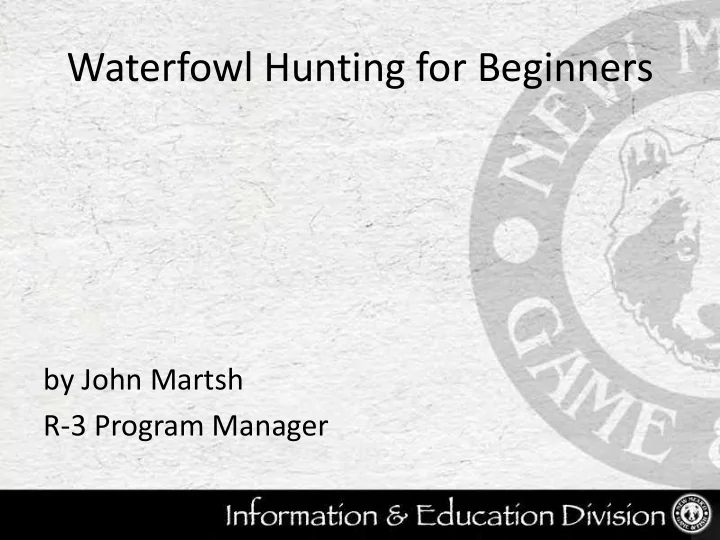

Waterfowl Hunting for Beginners by John Martsh R-3 Program Manager
Hunting Techniques: Spot and Stalk
Hunting Techniques: Decoying
Hunting Techniques: Pass Shooting
Gauge Sizes
Choke extracted from muzzle
Choke lengths and wall diameters Modified on left, Improved Cylinder on the right
Lead Shot versus Steel Shot
Shotgun Shell Lengths: 3.5”, 3” and 2 ¾”
Waterfowl Shot Size
Pre-season Scouting • Best done 2 weeks, or less, before the season starts. • Scout as many areas as possible and find micro-locations in those areas. • Micro-locations are specific spots that waterfowl are always at. • Determine land status and talk to land agents for tips and information.
Essential Equipment: Shotgun with break, pump or semi-automatic action
Essential Equipment: Ammunition
Essential Equipment: Waders and Face Mask
Essential Equipment: Hearing Protection and Fillet Knife
Essential Equipment: Hunting License and Stamps
Essential Equipment: Waterfowl Identification Booklet
Non-essential Equipment: Binoculars and Decoys
Non-essential Equipment: Dog
Non-essential Equipment: Lights and Calls
Non-essential Equipment: Water
Non-essential Equipment: Cooler and Gallon Freezer Bag
Practicing • Best done in the off-season. • Shoot skeet, trap and five-stand. • Pattern your shotgun. • Practice species and gender identification. • Practice different duck and goose calls.
Partnering with a Mentor
Proclamation
Post-season Scouting • Can be done a few days to a month after season ends. • Identify micro-locations where ducks like to loaf, feed, swim, sleep and hang out. • Micro-locations are useful when the following hunting season starts.
Rules and Regulations Top 10 1. Shooting hours are ½ hour before sunrise until sunset (unless otherwise stated in proclamation or on a posted sign on land you are hunting). 2. Non-toxic shot is mandatory to hunt waterfowl. 3. Anyone taking waterfowl must transport the edible portions of the meat from the field for human consumption. 4. Wounded birds must be killed immediately. Possession of live birds without a permit is illegal. 5. Migratory game birds may be taken with a shotgun fired from the shoulder, provided it is no larger than 10-gauge and is not capable of holding more than three shells.
Rules and Regulations Top 10 It is unlawful to: 6. Hunt while under the influence of alcohol or other intoxicants, including medical marijuana. 7. Take or attempt to take waterfowl by the aid of baiting. An area is considered to be baited for 10 days after the removal of the bait. 8. Use electronically or mechanically recorded calling devices, except during the Light Goose Conservation Order. 9. Shoot at waterfowl from within or upon a motor vehicle, motor- driven boat, sailboat or aircraft. However, a person may shoot from a motor-driven boat when the motor has been completely shut off and its progress therefrom has ceased. 10. Litter and/or pollute streams, lakes and other waters. This includes leaving spent shotgun shells.
Conclusion
Recommend
More recommend